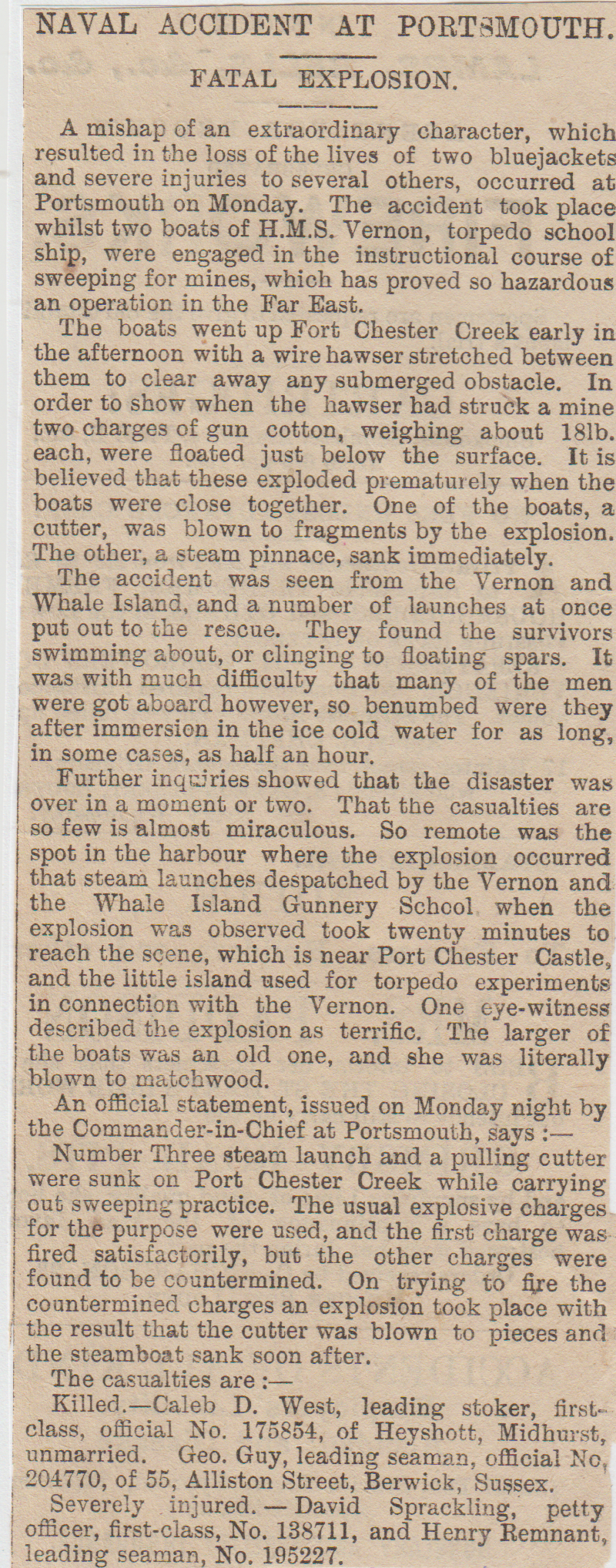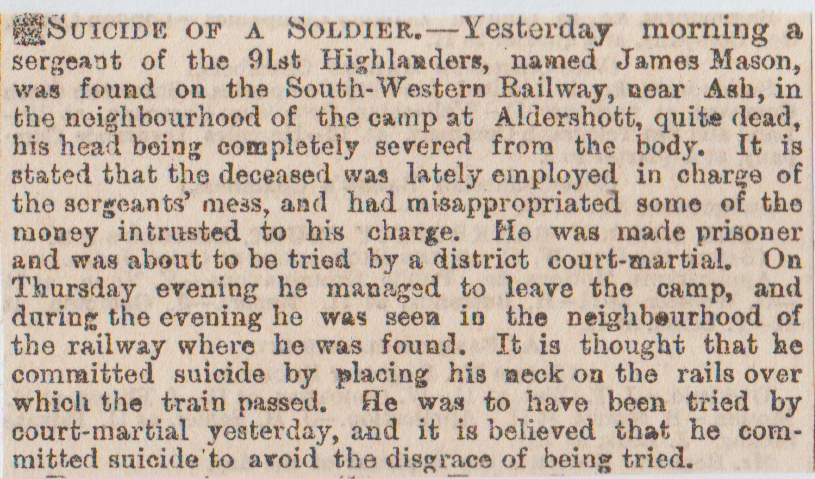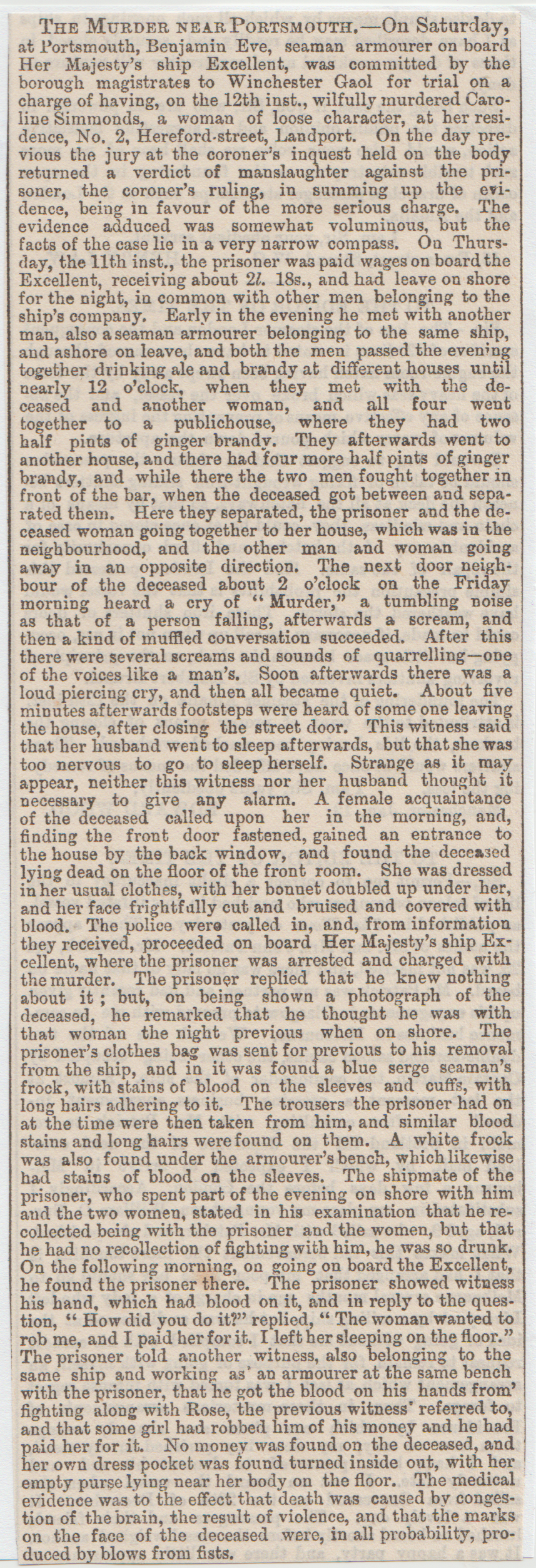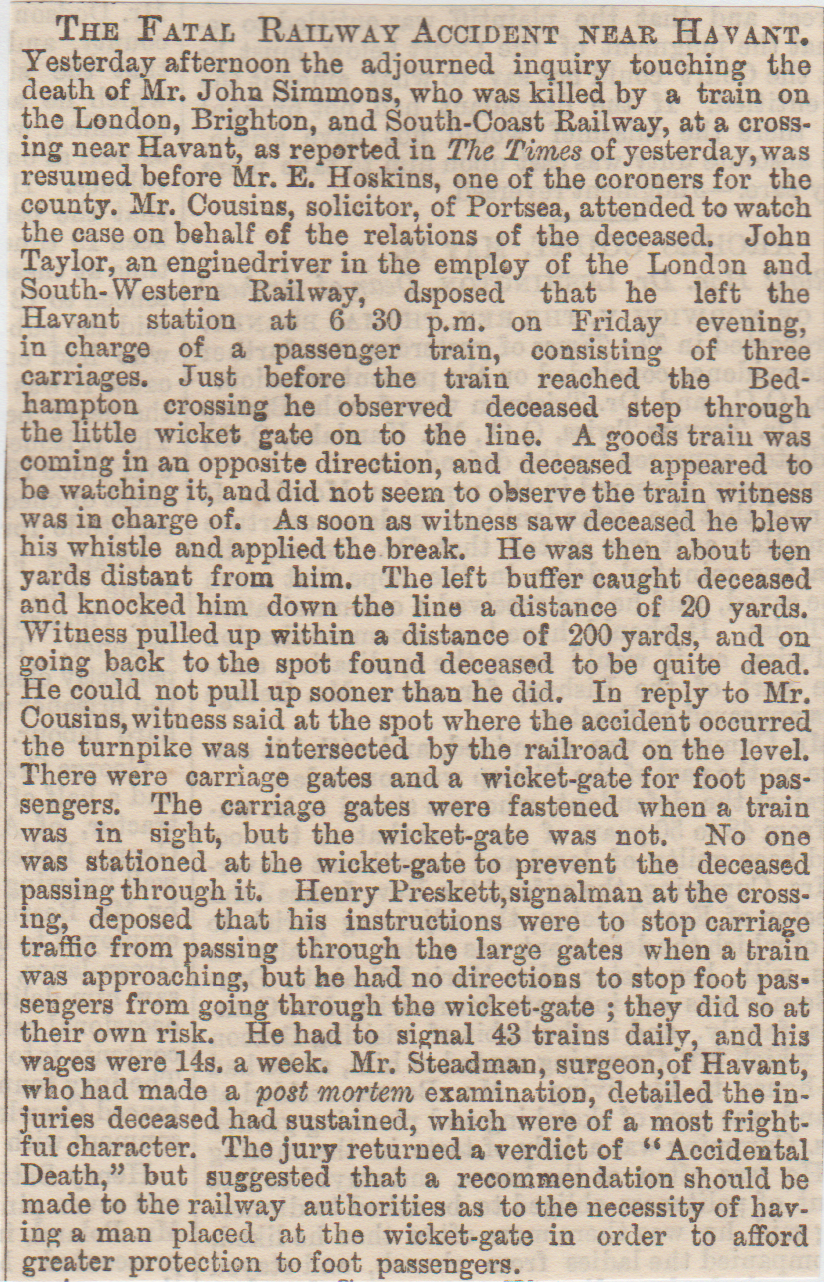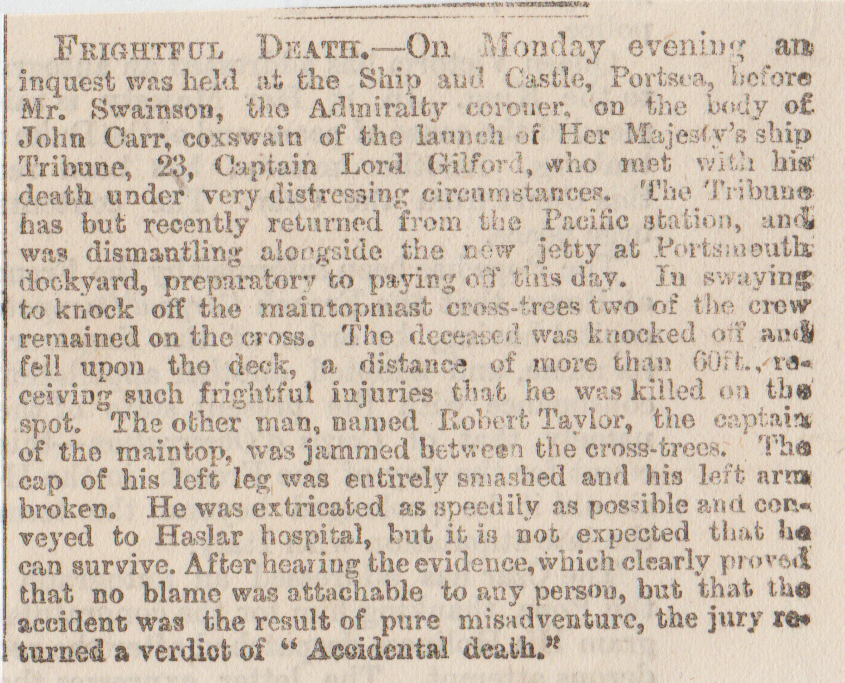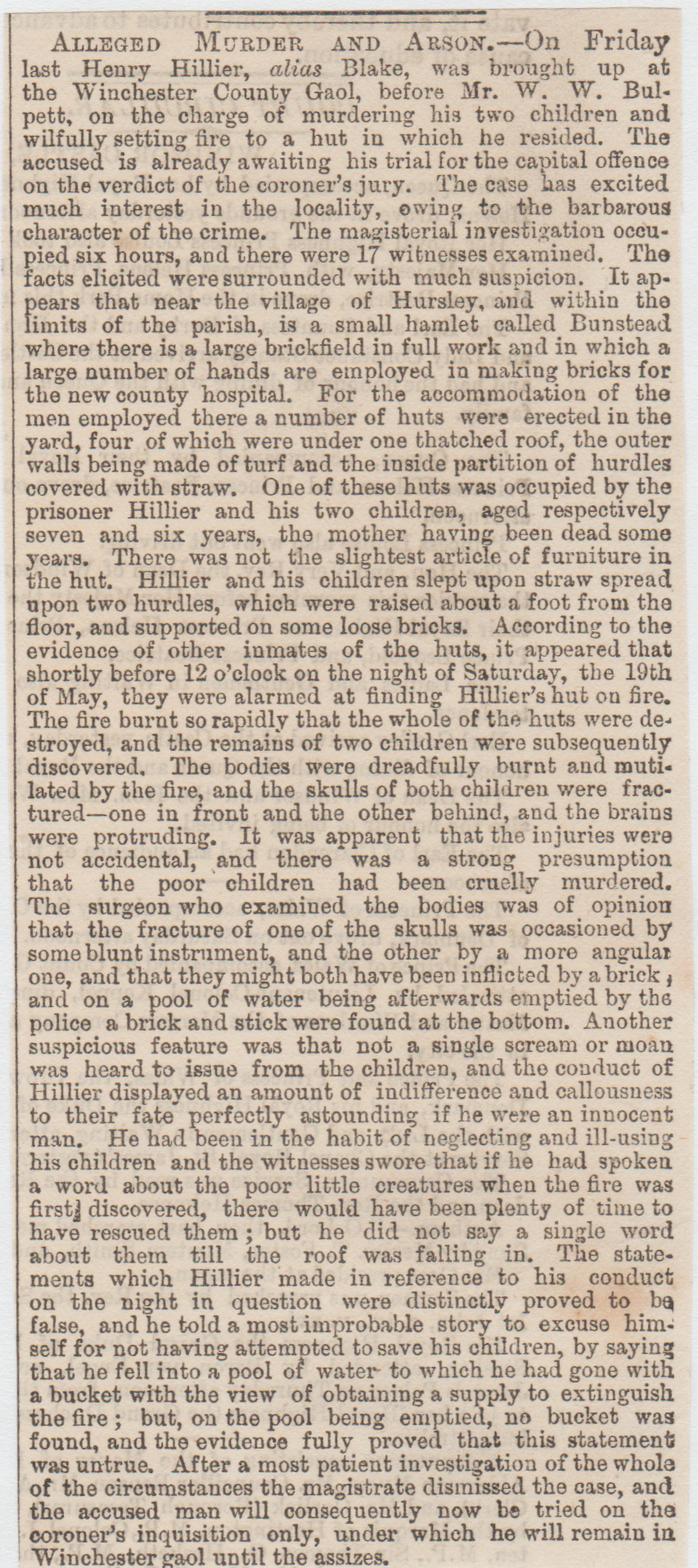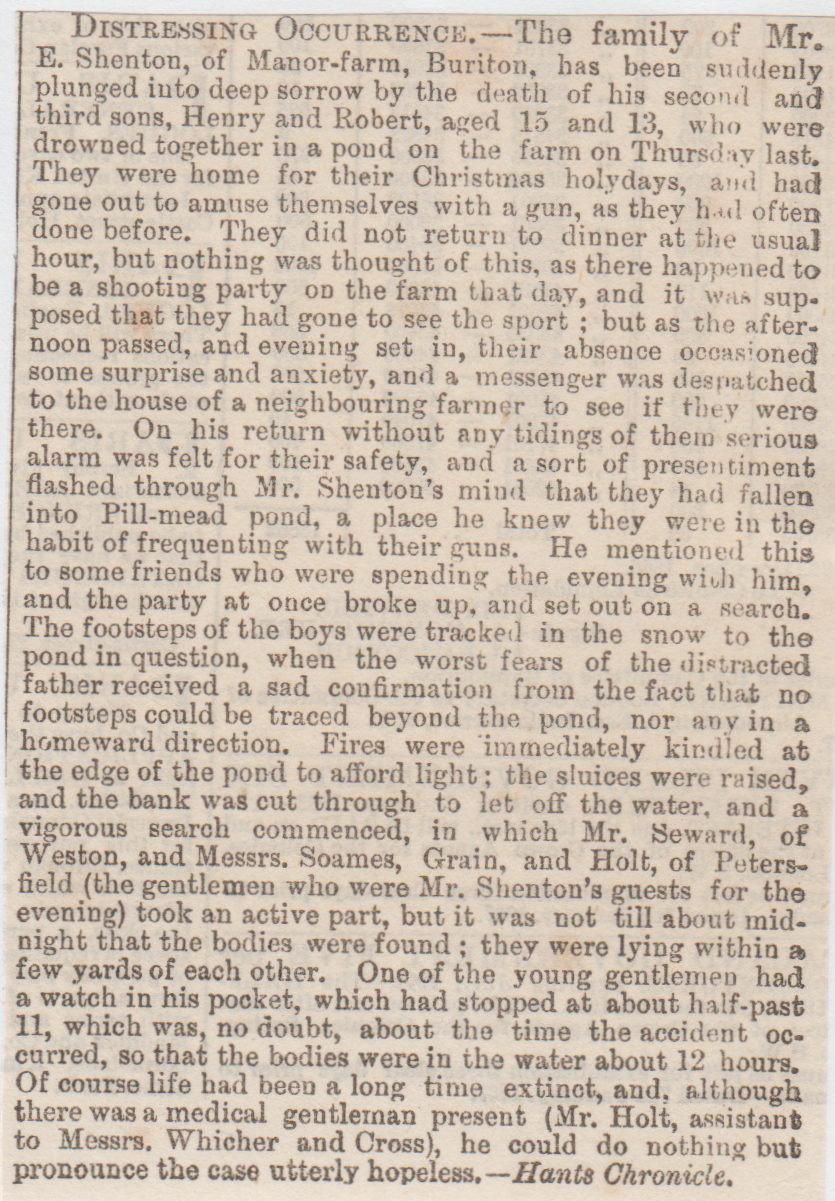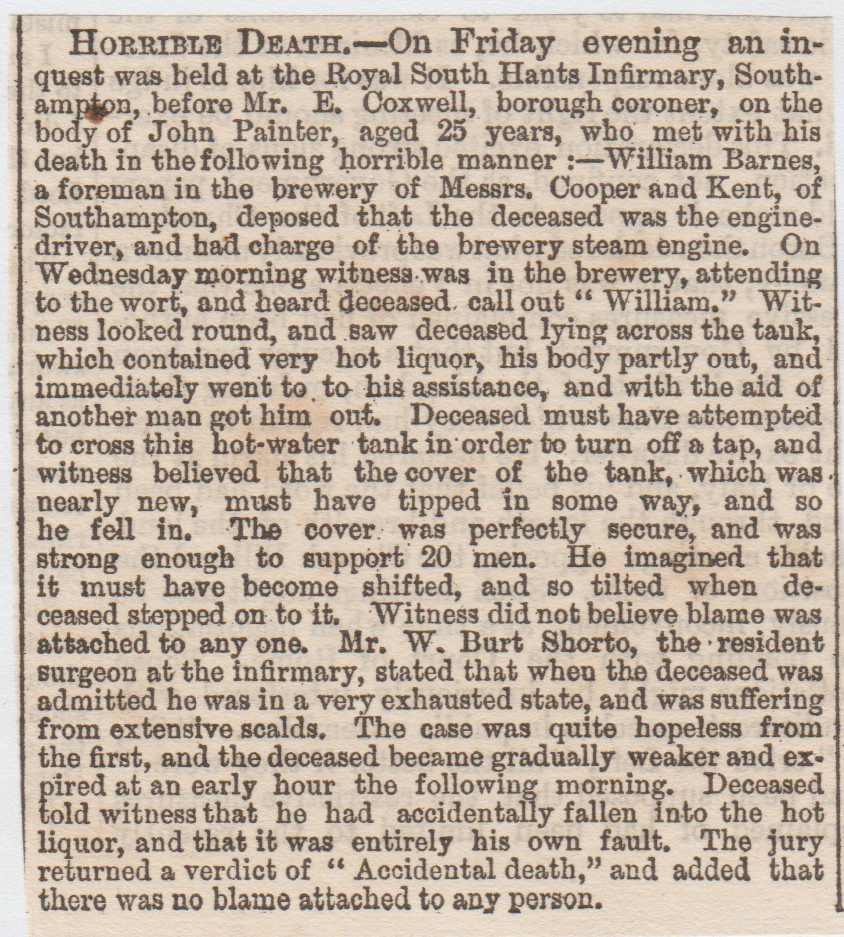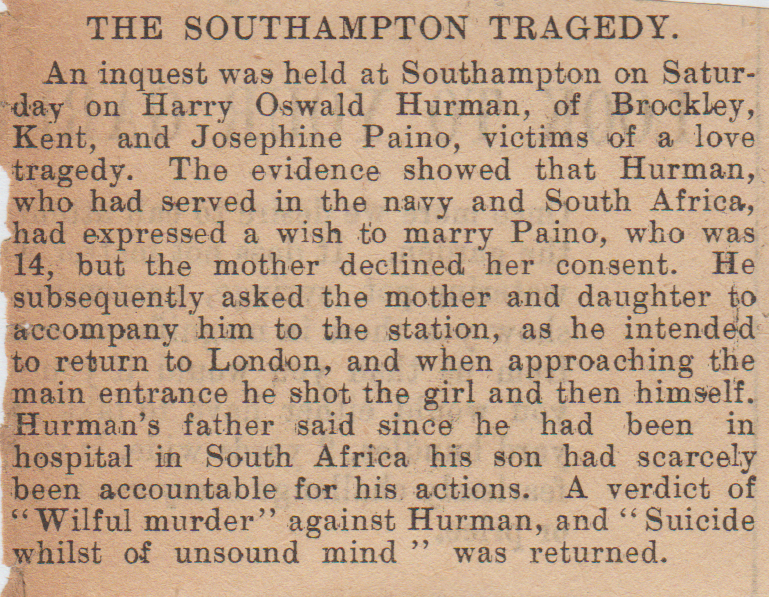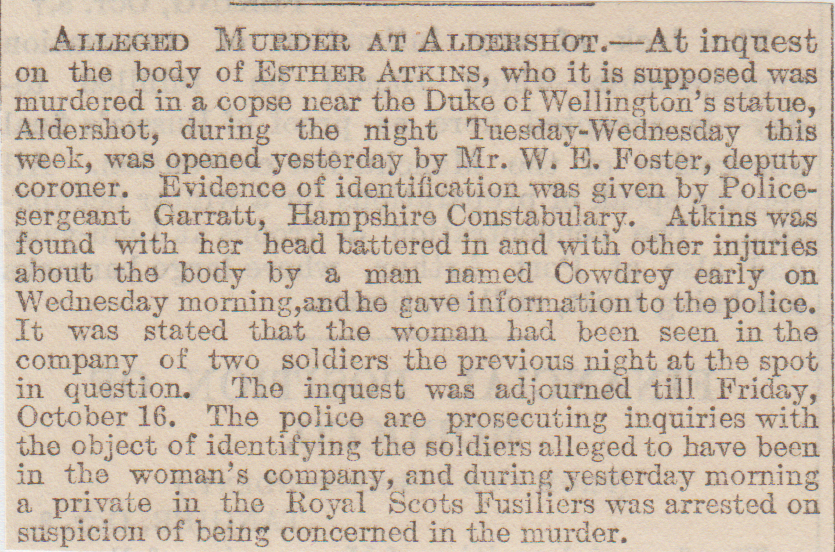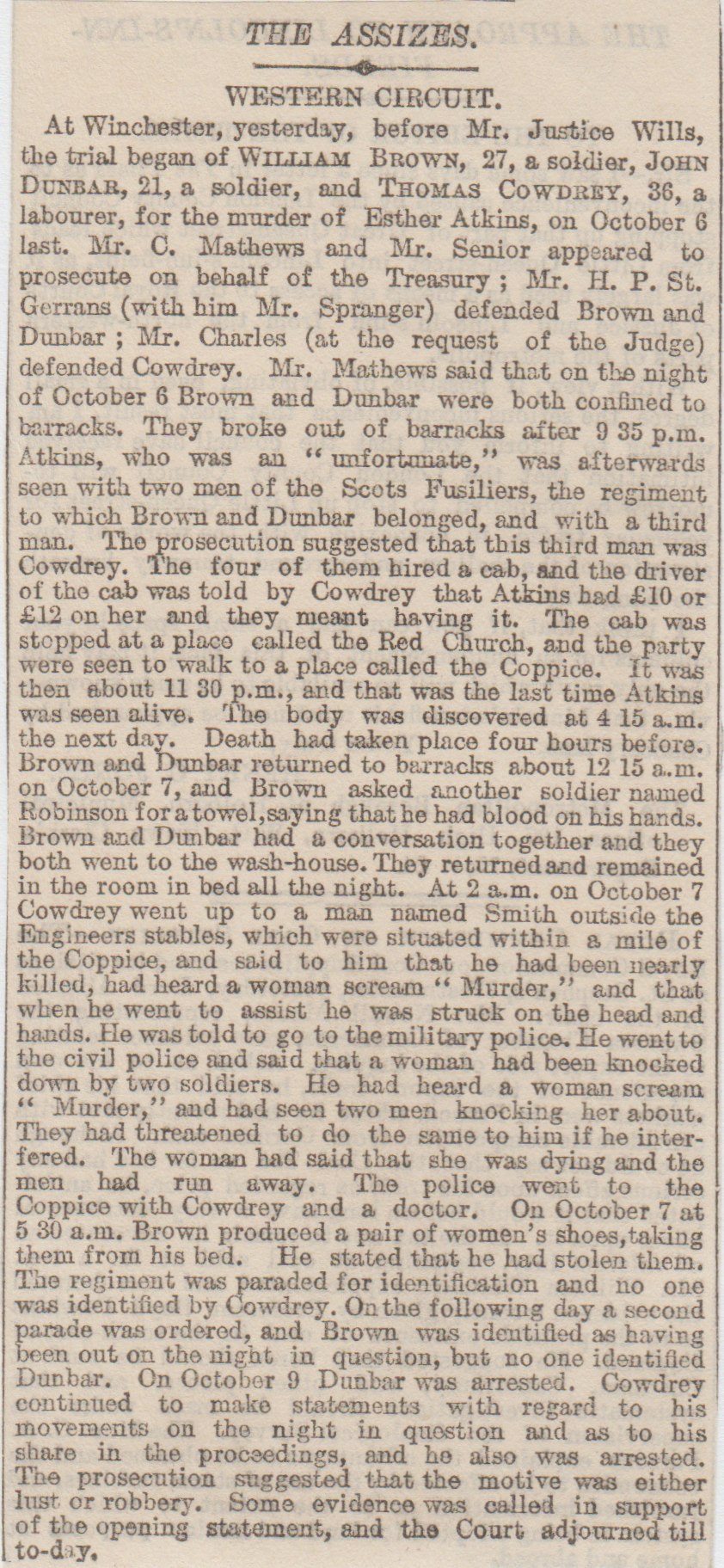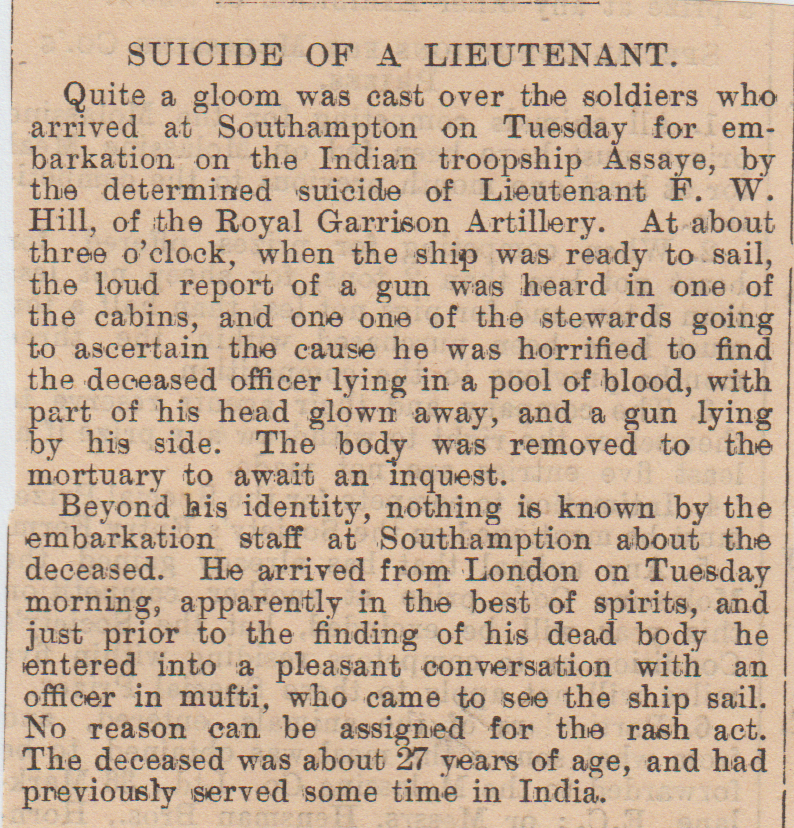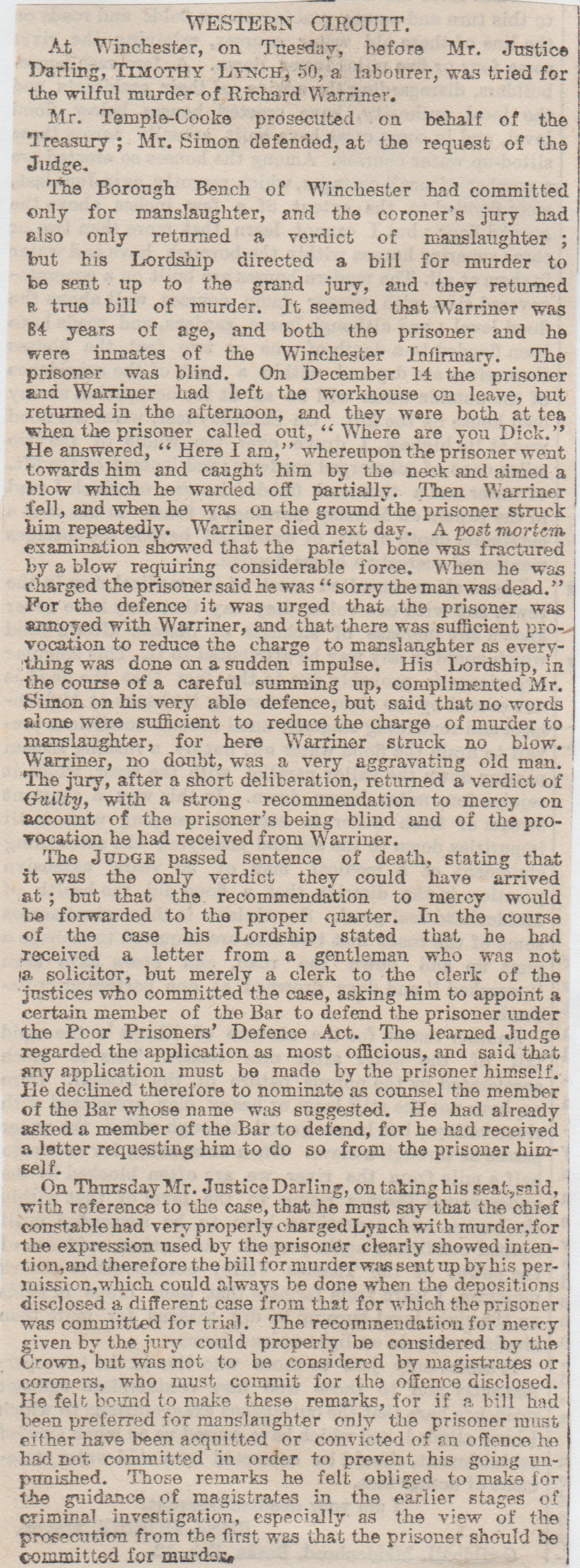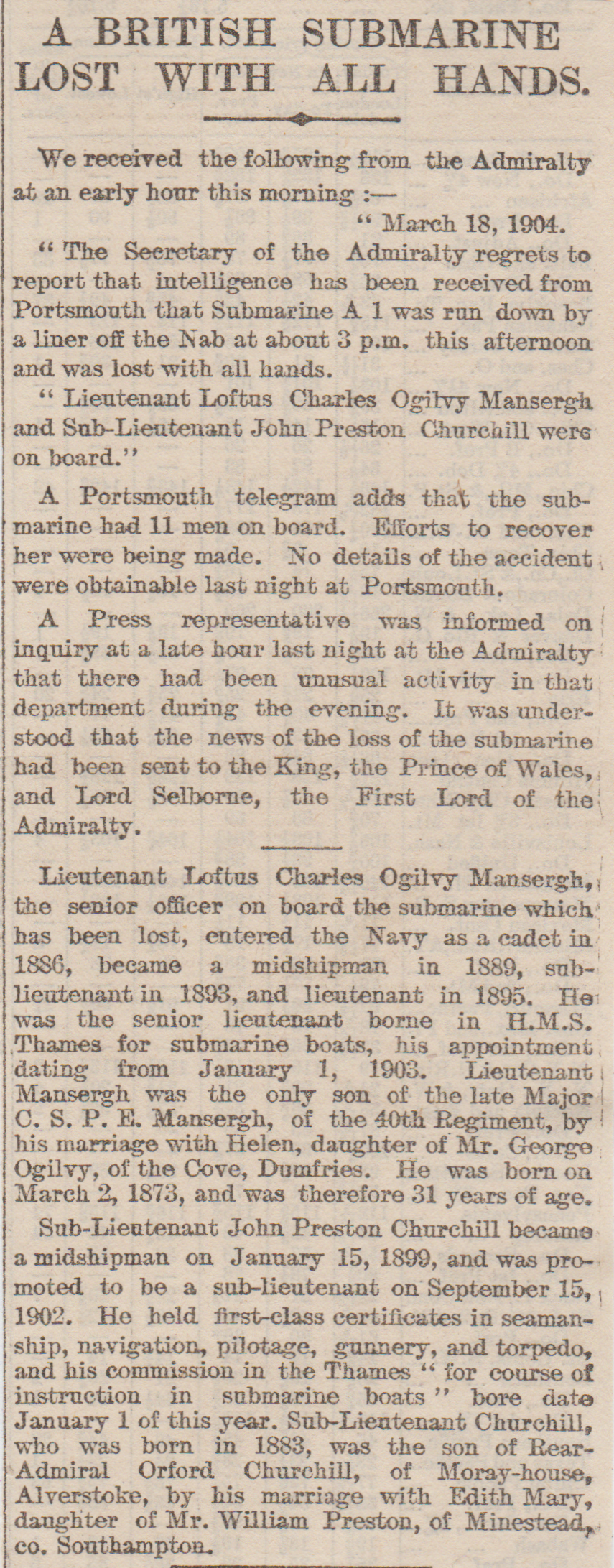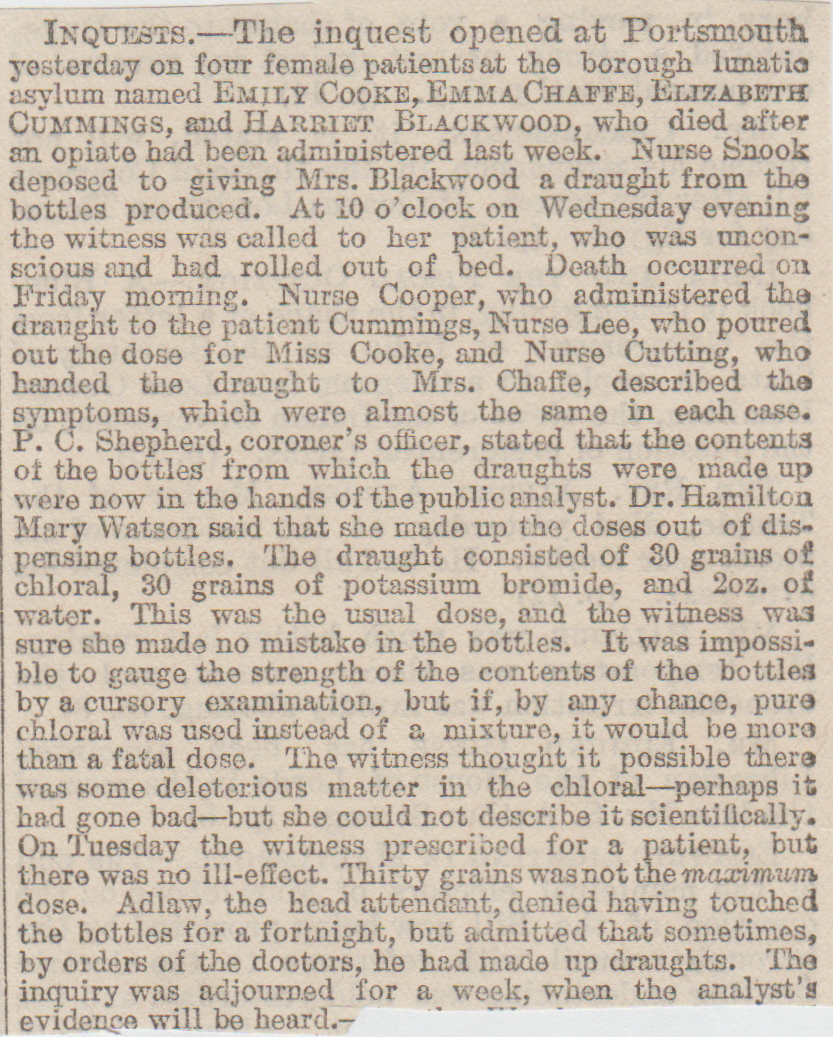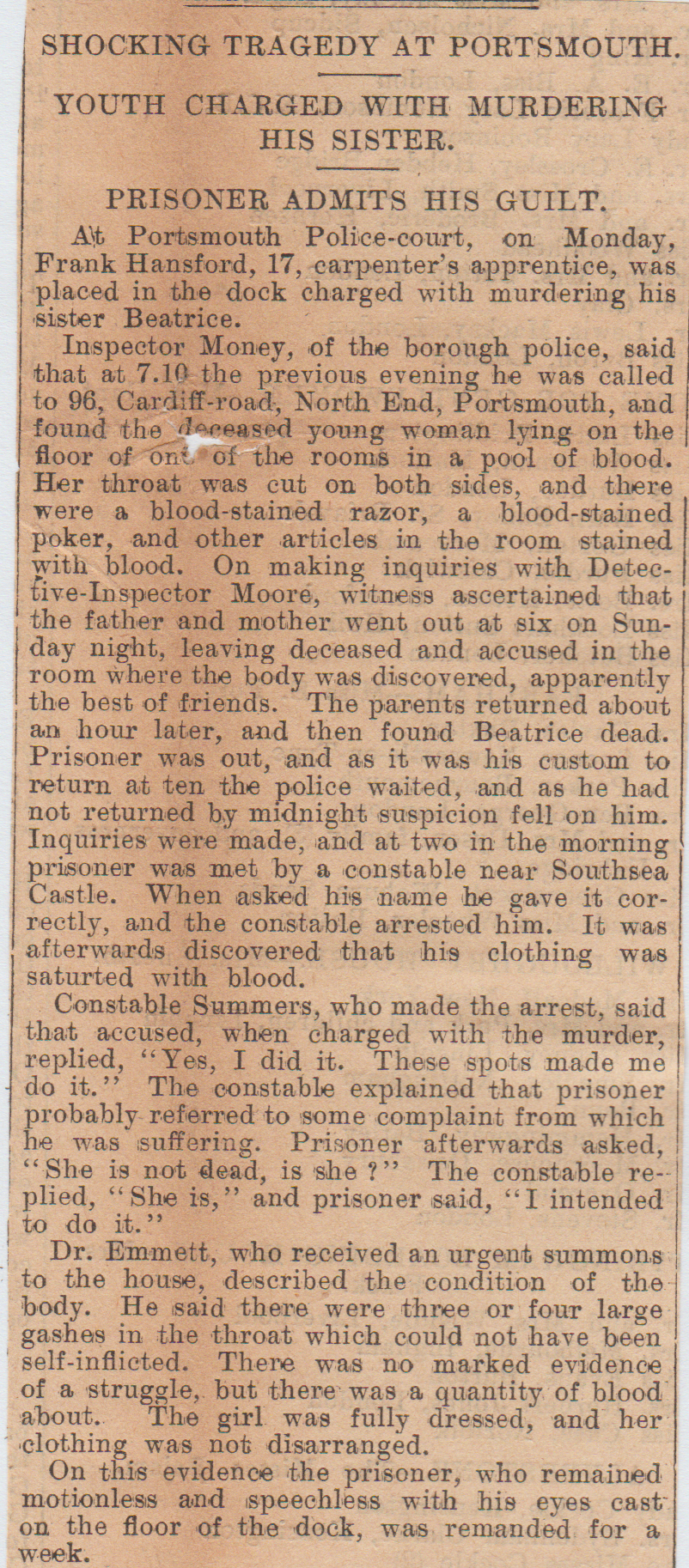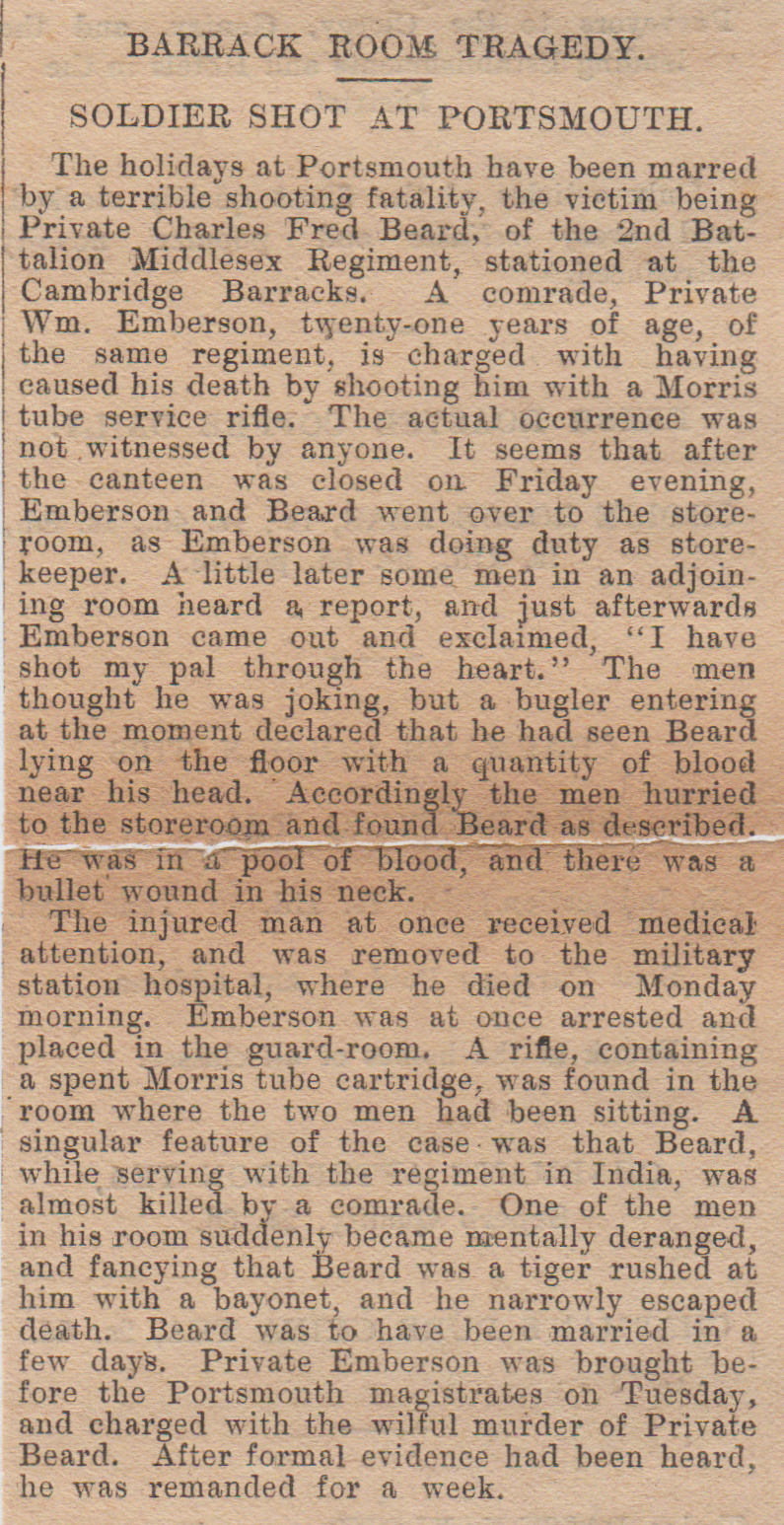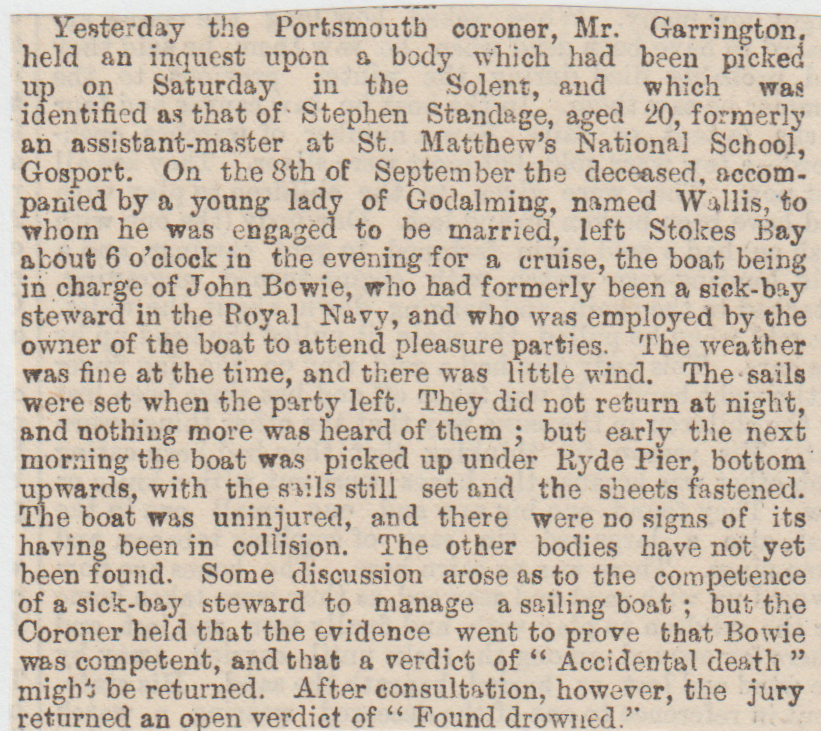1/ Southsea Pier Fatality, June 1907
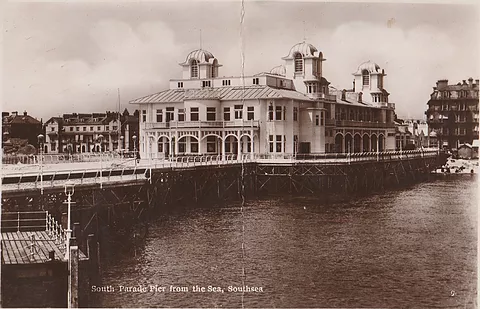
Three workmen were employed in the reconstruction of the Pier at Southsea when in a freak accident, a half ton girder fell into the water and sank the boat in which they were working. Two of them were rescued but Thomas Pinchborne aged thirty-six years was consumed by the Solent.
2/ Woolston near Southampton, May 1879 (Twisted bloody family or what?)
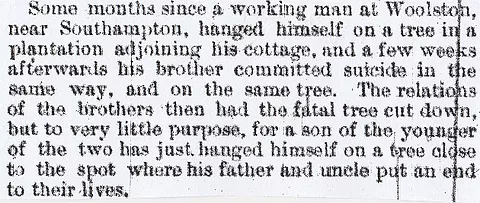
3/ Aldershot Murder, September 1884
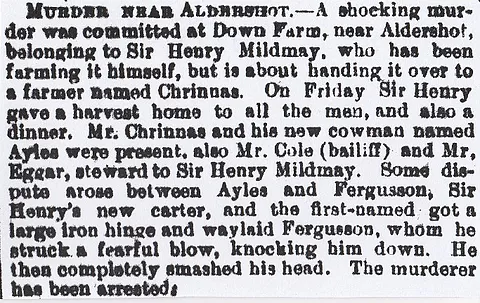
5/ Woolston near Southampton, April 1903 (Young Girl’s Remorse)
This is a story of remorse and how it can affect you. Kate Ranger took her little sister out for a walk on a Bank Holiday and lost her. This had a terrible effect on the sixteen-year-old lass. Thinking she’d be lying dead somewhere, she proceeded to hang herself. Tragically just after finding her body, it turned out that her sister had been found and was safe and sounds with family friends.
6/ South Cavalry Barracks Suicide, Aldershot, August 1896

7/ Strange Aldershot Fatality, October 1896

8/ Eastney Barracks Murder/Suicide, Portsmouth, January 1910
A sergeant of the Royal Marine Artillery was found with a female on the beach near Eastney Barracks in Portsmouth. Henry Cheeseman and his sister-in-law, who had been living with Cheeseman and his wife and family, is believed to have killed her first and then himself. A letter was found with the bodies, but police never disclosed any of the details therein. Police have questioned neighbours and it appears that a shot from a rifle was heard the night before and in the area where the bodies were discovered. They were found by a coastguard, while he was patrolling the area and judging by the injuries sustained it seems that Cheeseman stood over the woman and shot her at point-blank range with his Lee-Metford rifle, then walked up the beach for a few yards and then shot his own brains out. Her brains were protruding and he only had half a head. The woman held a fur boa to her head when she was shot and has been identified as a domestic servant named Lefevre, twenty-one years of age.
9/ Southampton Suicide Pact, March 1919
A suicide pact between two girls was committed at Southampton. Ada Mary Brown who was eighteen and Daisy Winifred Holloway, aged sixteen were both found drowned in a pond with their wrists tied together with a scarf. A letter was posted by Daisy, shortly before her suicide and arrived the day of her death and it read:
“I am, oh, so tired of life, and so have put an end to my miserable existence. I must close now, my time is very short, Your broken-hearted daughter, Daisy P.S.- I am not alone in doing this thing. I don’t think I should have the courage alone, but Ada is going with me, mother. I am too tired to wish to live. Life is such a mockery.”
10/ Dogmersfield Park, April 1875 (Butler Suicide)
The butler to Sir H.Mildmay of Dogmersfield Park, Hampshire, had just attended to his duties, then he went upstairs to his living quarters and cut his throat with a pair of scissors. Other servants found him sitting on the floor trying to get his fingers in the wound and pull it open. Doctors tended to him and managed to keep him alive, but he eventually slipped away a day later. The verdict was “Temporary Insanity.”
11/ Aldershot Fatal Affray, July 1885

12/ Gosport, February 1901 (Murder/Suicide)
William J.Cooper, murdered his four-year-old son, Albert Edward, by shooting him in the head as he lay in bed and then he committed suicide by shooting himself in the head also. Cooper was a widower and had a couple of kids, but since he lost his business and his wife, things got on top of him and he decided to commit this heinous crime.
13/ Aldershot, August 1918 (U.S. Soldiers Suicide)
A United States engineer, Private Leslie B.Handy, aged twenty-six, shot himself at Cowshot Camp while under detention. Captain Axtell of the U.S.Army said some money went missing, so the men in the tent were searched and the money was found in Hardy’s possession, so he was placed under detention in his own tent. The guard left him alone for a moment and then heard a shot.
14/ Eastney, Portsmouth September 1906
The Reverend J.White, retired minister, was drowned while bathing at Eastney, Portsmouth. His brother-in-law made desperate but ineffectual efforts to save him.
15/ Swanwick Murder, April 1899
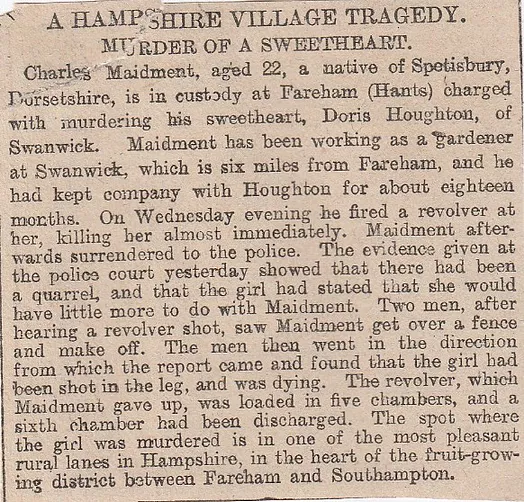
Charles Maidment, a market gardener aged twenty-two, fatally shot his sweetheart, Doris Houghton at Swanwick near Fareham. He afterwards surrendered to police. It is believed that there had been a quarrel between the couple.
16/ Andover Suicide, January 1905
George Gould came into Andover with his mother to see his brother, who was in the hospital with influenza. They booked in at the Star Hotel, then went to the hospital to visit him. On returning from the visit, George went up to his room and when he didn’t answer her calls, she opened the door and found him covered in blood. The hotel manager sent for Dr.Gillett who pronounced him dead, due to his self-inflicted gash in his throat; the razor was by the side of the bed. Gould himself had recently had a bout of influenza and he had been very down in the dumps of late.
17/ Southampton Servant Suicide, March 1918
A domestic servant, Kathleen Jane Palmer aged seventeen years, drowned herself in the river. Palmer had been told off by her mistress for borrowing her clothes to go out to the theatre in. Suicide during temporary insanity was the verdict at the inquest.
18/ Southsea Filicide, November 1902
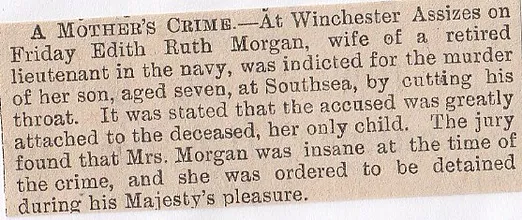
19/ Basingstoke Canal near Aldershot, March 1897
The body of a young female was found floating in the Basingstoke Canal near to the Government Sewage Farm. Her identity was established as that of a girl who was locked up a few months ago, by the name of Mabel Andrews, but she was taken back to London by her father and said her name was Louisa Turney. The corpse of the woman had been in there for about a month or so and she was badly decomposed. (What happened here?)
20/ Portsmouth, January 1899 (Suicide on a Warship)
At 11-30 a.m.on New Years Day, a dreadful discovery was made on board her Majesty’s torpedo destroyer Star, moored at Fountain Lake near Portsmouth. The warrant officer, Mr Collins, had to go to the commanding officer’s cabin, who is absent on leave, when he found the body of Robert Bowman who was a first-class petty officer, on a chair just inside the door. Between his legs was a rifle and the muzzle was placed in the mouth and the bullet passing through the back of his skull. He had taken off his boot and sock on the right foot and pushed the trigger with his toe. A man on a boat near the Star, the Flying Fish, heard what he thought was a gunshot, but passed it off as nothing. The deceased was from Edinburgh aged thirty-three and had no wife or children.
21/ Arundel House, Grayshott, December 17th, 1915
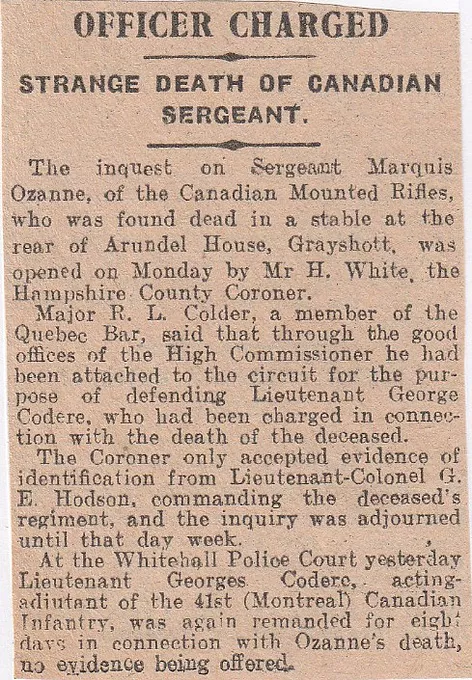
Grayshott Murder, December 23rd, 1915

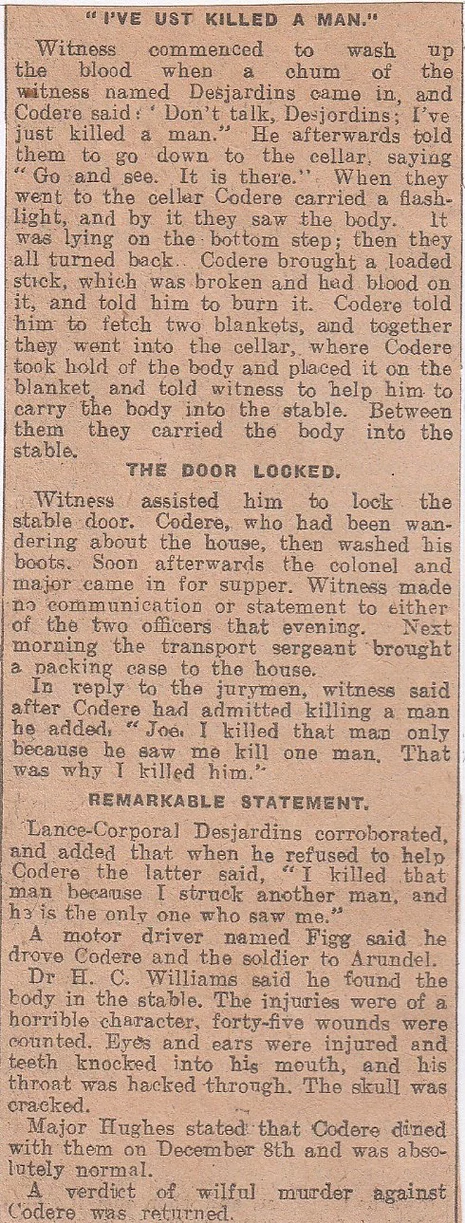
22/ Hilsea Barracks Suicide, Portsmouth, June 1869
An 11th brigade gunner, Royal Horse Artillery, by the name of John Merry, at Hilsea Barracks near Portsmouth, was told a week ago that he was reduced from the rank of Bombardier for serious misconduct. This week he was found sitting down in a water-closet, with a carbine rifle tucked between his legs and his brains blown out.
23/ Pure Drop Public House, Southampton, September 1894 (Attempted Murder/Suicide)
The landlady of the Pure Drop public house in Broad Street, Southampton, only had two customers in the bar, so she left them alone, while she did some chores. A few moments later she heard screams coming from the bar and she found the woman laid on the floor with her head nearly severed off. She rushed outside to get help and quickly returned, where she saw the man with his throat slit. When the body was identified later on, she had the name of Jupes and the man, named Rogers, had been harassing the poor woman. Rogers was a seaman and had done some prison time for assaulting her husband and the attack on her was down to the prison term and her constant refusal to have anything to do with him. (Is pub still there?)
24/ Russell Street Fire, Southampton, February 1899
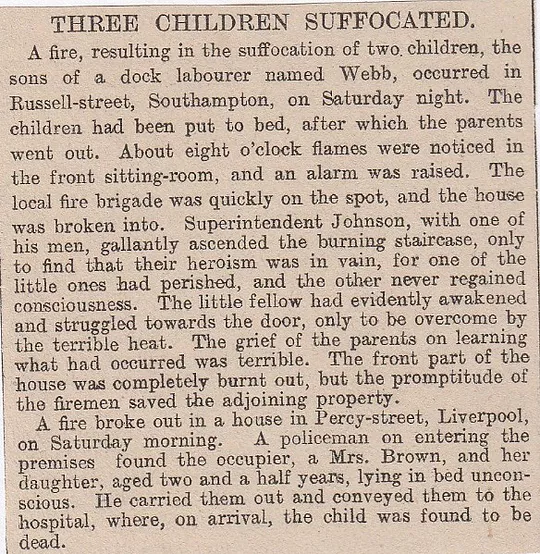
25/ St Paul’s Square, Southsea, March 1894 (Murder or Suicide?)
A shocking discovery was made at 37, St Paul’s Square, Southsea, home of Malcolm Stace a retired naval surgeon. Mrs Stace left the house several days ago and had not been seen since. After his wife’s disappearance, they searched high and low for her until someone suggested that they try the locked kitchen door, but Mrs Stace was the only one who had a key for it so they left it. Later on, they decided to force open the door and went into a disused coal cellar. There on the floor of the cellar was his dead wife, but as of yet, it is uncertain whether it was suicide or a tragic accident.
26/ Portsmouth Murders, September 1885
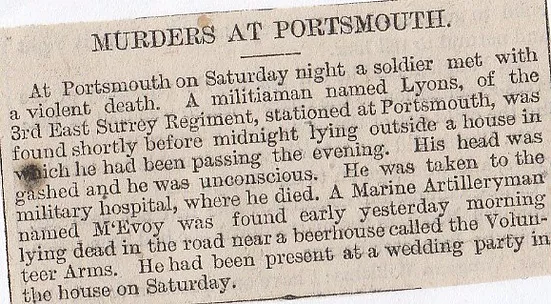
27/ Cottonworth near Andover, December 1903
William Walter Hart from Salisbury had been visiting relatives in Cottonworth near Andover, when he was found dead in the garden with his head blown away and a discharged gun next to the body. This one is a bit of a mystery, looks like self-destruction, but it seems to be a terrible accident.
28/ HMS Royal Sovereign Suicide, Portsmouth, June 1891
The HMS Royal Sovereign was lying in the repairing basin at Portsmouth Dockyard. The men all left on Friday night, from their reparations on the ship, but one of them was not seen. Thomas Richard Dale, shipwright, didn’t clock out and he was next seen on the following morning hanging from a beam in one of the after coal bunkers by a driller. No reason is attributed to the act and the fellow had been only been married less than a month.
29/ Aldershot Landslip, October 1885
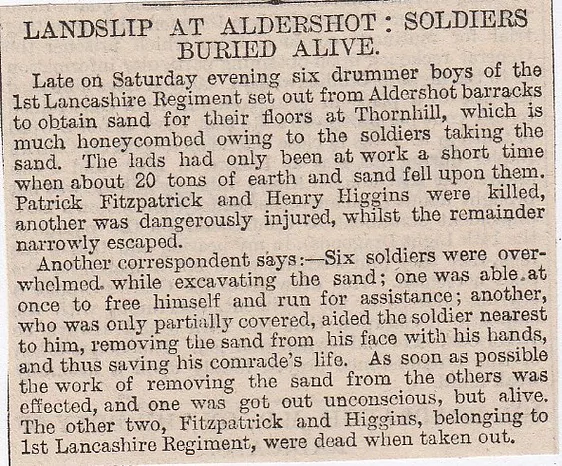
30/ Milton Lunatic Asylum Suicide, Portsmouth, May 1899
At the lunatic asylum at Milton, Portsmouth, Thomas Hardwick, a 28-year-old who had been in the Army in Egypt and was declared insane. An attendant named Arthur Himmens was slicing bread for breakfast and Tobin, another assistant, was buttering it. A group of inmates were hanging about waiting for breakfast when Hardwick spotted the knife not being used, grabbed it and ran off. Tobin and Himmens ran after him but Hardwick stopped and slid the knife across his throat. He died twenty minutes later.
31/ Titchfield Murders, April 1892
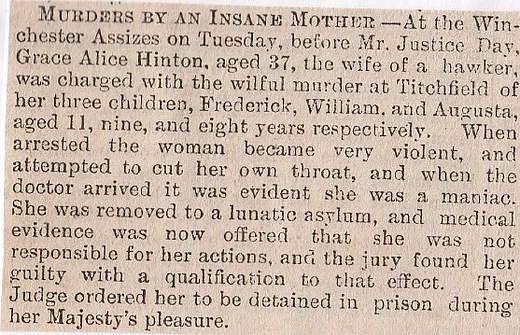
32/ Portsmouth, June 1899
An inquest respecting the death of William Clark of Malsham, Wiltshire, who was shot by Private Day of the Rifle Brigade. Clark was lying in a bush and Day, seeing some movement, fired into the bush under the impression that a rabbit was there. A verdict of death by misadventure.
33/ Aldershot Camp, August 1890 (Struck by Lightning)

34/ Aldershot Manslaughter, February 1900
Private John Adams of the 3rd East Surrey Regiment, died at Cambridge Hospital, Aldershot. He was brought in from Woking in Surrey, totally unconscious and he never came out of it. He had terrible injuries to his body and head and this was as a result of his comrades giving him a good kicking because he didn’t volunteer for active service. The military has been greatly embarrassed by the situation and promised to look into it in great detail.
35/ Portsmouth, September 1846 (Attempted Murder/Suicide)
A private from the 13th Regiment killed himself at Portsmouth, by shooting himself. The unnamed soldier had been residing in Popes Lane with a girl, but one night he became jealous and he went his barracks, got his rifle and fired at her, missed, then turned the gun on himself by tying it to a window sill and attaching a piece of string to it and then pulling the trigger. (Did she make it ?)
36/ Southampton, October 1875 (Greedy Undertaker)
The premises of an undertaker named Blundell were found to contain the bodies of thirteen children. It is thought that he’d taken the money for kids to be buried, then cruelly just left them to rot on his Southampton premises.
37/ Shirley (Wife Murder/Suicide) March 1885
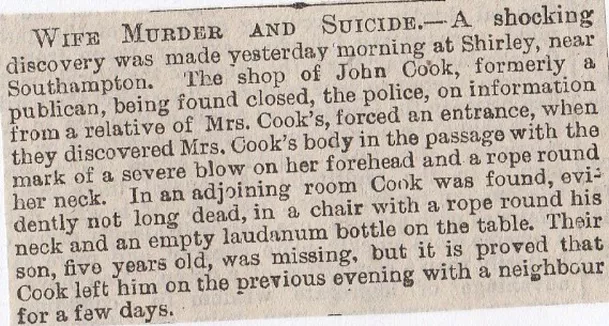
38/ Bishopstoke Suicide, near Eastleigh, December 1848
An inquest was held on the body of Mrs Twynam, wife of Dr Twynam, of Knowle Hill near Bishopstoke. She had long been in a depressed state and this culminated when she shot herself in the head. The jury had to view the body and some were horrified to the state of it, with half of the face blown away. Sarah Barber, the housemaid, said she saw her take breakfast with the doctor and then go for a walk. On her return, she asked the cook what she wanted for dinner, then told Barber to dust her bedroom. (Typical day of a Victorian lady, it seems!)
When Barber finished dusting, she came down and went into the front room, which smelled of gunpowder and was a bit smoky she said. Another servant, Mrs Vear, came in and saw Mrs Twynam, and Vear covered her head with an apron. The staff had been told to keep the knives out of her way, as she had cut her arm with a knife about a month ago. She had also attempted to poison herself, so clearly a suicide risk for some time. Mrs Twynam was sat in a chair, head tilted to one side, left side shattered, dark gunpowder burns on it as well. The gun was wedged between her legs with the barrel pointing upwards and the poker she had used to push the trigger, was near the body. Apparently, she had “disease of the brain” which effected her nervous system (Parkinsons?). Verdict “Temporary Insanity.”
39/ Browndown Camp Fatal Stabbing, Gosport, January 1899

40/ South Stoneham Double Suicide, June 1848
Two young girls were found in a stream at South Stoneham near the river Itchen, clutched in each other’s arms in what seems to be some sort of suicide pact. The stream runs through Farmer Sly’s meadow, behind the church at South Stoneham. The two girls were sisters, Ellen and Jane Hughes, aged fifteen and nineteen respectively. They both worked for F.Cooper, a surgeon in Southampton, but one was sacked three weeks ago and the other left with her sister. A boy had noticed something in the stream about a week ago but never investigated any further, which suggests they had been there for a week or so. They were locked in each other’s arms and found next to the wooden bridge.
41/ Winchester, July 1895 (Homosexuality?)
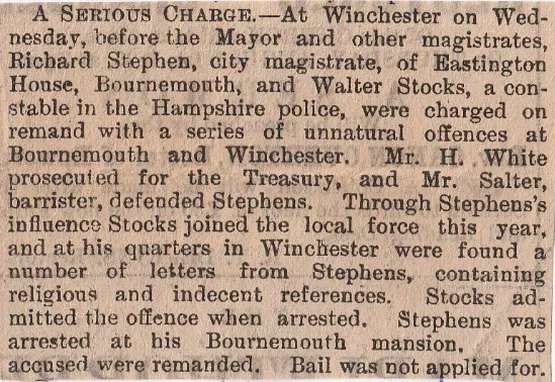
42/ Duke of Buckingham Pub, Portsmouth, July 1905 (Murder/Suicide)
Frederick Woodward, a gunner of the Royal Garrison Artillery shot Lizzie Dyer in the Duke of Buckingham public house. They met three months ago and Woodward was described as obsessed with Dyer, who was married to a Marine who was at sea but told him she was not seeing anyone. Dyer came in the side door of the pub and Woodward came in soon after and both were chatting for some time, when three shots were suddenly fired, followed by the thud of the bodies hitting the floor. Police were called in and he was barely alive, but she was stone cold. He shot her with his Army-issued revolver and some bullet holes were found in the walls. (Is pub still there?)
43/ Southampton/Eastleigh Fatal Collision, July 1890
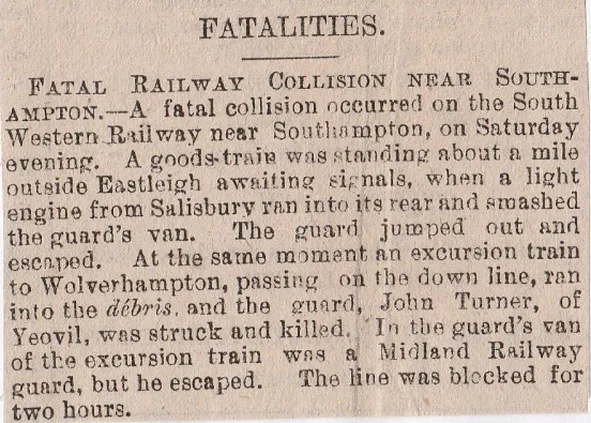
44/ Portsea Servant’s Suicide, January 1861
A sad tale of domestic servant Honor Whittenham, who worked for Dr Carter of Portsea. Honor had been engaged to a London copper, but he’d been seeing another girl with £600 in her bank account, so it was no contest. Poor Honor bought a couple of packets of “Battles Vermin Killer” (killed more people than vermin, this stuff!), and swallowed them both. A letter was found addressed to her brother, and it read:
“My Dear Friends- I have poisoned myself, and I hope you will not have me pulled about, for I am in great trouble, and have been ever since about seven weeks before I left Mrs Rose; and I was ruined there, and I have not told anyone. I have wished many and many a time that I had never left Mrs Gooch, for I was happy there. Oh, my tender mother, where must I go, and what must I do?Oh, my dear Lord; Oh, what can be done for me, for I am a great sinner?”
45/ Southsea Murder/Suicide, February 1899
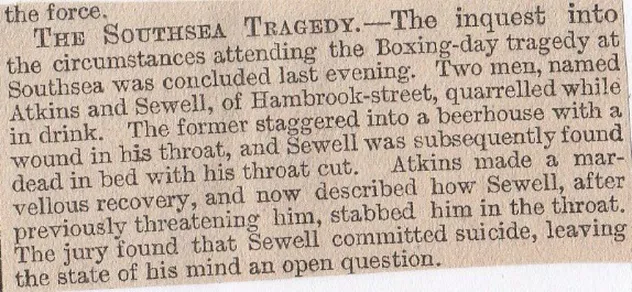
46/ Winchester Barracks Suicide, November 1868
A mess servant at Winchester Barracks and a private of the Rifle Brigade, David Tague, shot himself in the head in the mess kitchen. His face was blown away when his body was found at seven a.m. He’d been in the Army for a dozen or more years and he was a borderline alcoholic.
47/ Portsmouth Fatal Explosion, December 1904
48/ Aldershot Soldier Killed, December 1904
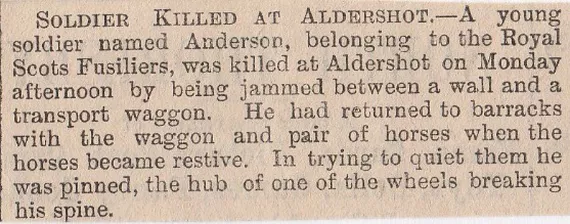
49/ Hinton Admiral, (Tragic Accident), November 1860
Sixteen-year-old Miss Emily Entwistle died in a dreadful accident. She was riding through Winkton on horseback with the groom behind her, when they rounded a corner and her horse shied and threw her off. She didn’t hit the ground but was suspended from the saddle and the horse flew off at full gallop with Emily tossed around like a rag-doll for about hundred yards. A boy saw the horse and Emily coming towards him and he tried to stop the animal, but it swerved and her head struck the cartwheel which the boy was riding on. The cut to her head had “severed the scalp from the nose to the back of the head”. Her foot was caught in the stirrup and even after this ordeal, the horse carried on, and when she finally became disentangled she was quite dead.
50/ Blacknest, January 1865 (Tree Climbing Accident)

51/ Southampton Fire Fatality, October 1881
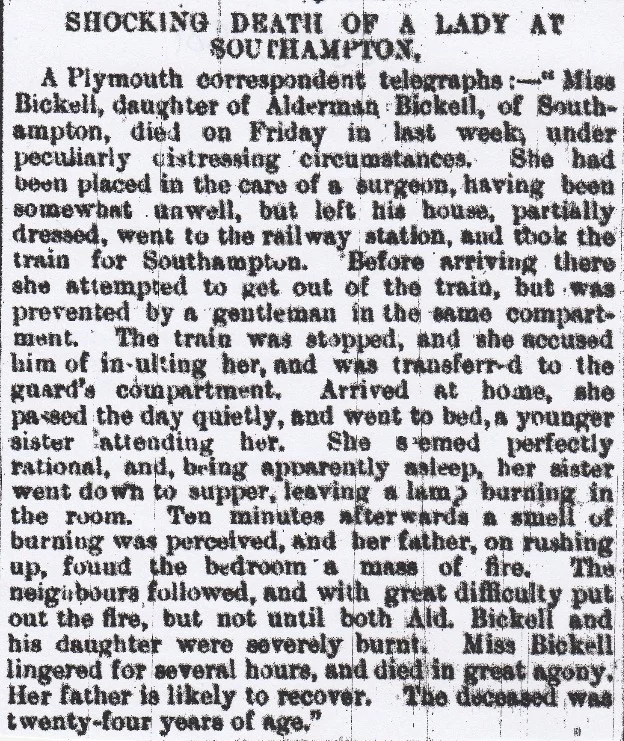
52/ Southsea/Gosport Drownings, August 1896
A lad named Archie Curtis was drowned at Southsea on Saturday morning while bathing. A child named Reginald F.Callaway, the son of a professional golf player, has been drowned at Fort Monckton near Gosport, through falling from the sea-wall while playing there. It is stated that the day of the accident was the sixth anniversary of the death of another child of Mr and Mrs Callaway at the same spot.
53/ Southsea Castle Lighthouse Death, September 1908
The lighthouse-keeper at Southsea Castle, William Craven, noticed that the light was not functioning properly, so went to the bottom and unscrewed a plug and the lower part of the gas pipe to let off accumulated water. He had to go into a pit to do this and is believed that a gas leak overpowered him and as he was in his late seventies he couldn’t muster the strength to get out. He was found in the pit with the gas still leaking out.
54/ Aldershot Soldier’s Suicide, December 1870
55/ Portsmouth Murder (Hereford St, Landport) January 1866. (Landport was the birthplace of Charles Dickens)
56/ Fatal Railway Accident near Havant, May 1866
57/ Singular Fatality at Southsea, May 1866
At Southsea yesterday a little girl named Bowyer, aged nine was running along the pavement with a glass bottle containing stout, when she stumbled and fell. The bottle broke off at the neck, and the edge, which was jagged, was driven with considerable force into her neck and inflicted a frightful wound. The child was taken home, and Dr Yardy, surgeon, was sent for, but life was extinct, the glass having pierced the main artery of the neck and caused almost instantaneous death.
58/ Fatal Fall From Mast, Portsmouth, May 1866.
59/ Murder and Arson near Hursley, June 1866 (Bunstead)
60/ Soldier’s Suicide at Portwood, March 1867 (Portwood is a suburb of Southampton. Bridge over Itchen from St Denys)
61/ Buriton Drownings, Manor Farm. January 1867 (Big pond near the church, called Buriton Pond. Pillmead House and Pillmead Cottage are both on North Lane. Manor House next to the church. WOW!
62/ Scalded to Death in a Brewery, February 1867 (William Cooper & Co, East Street, Southampton)
63/ Accidental Shooting at Blenheim Barracks, Aldershot. March 1902 (Two killed)
A yeoman was cleaning his rifle at Blenheim Barracks at Aldershot, on Wednesday, and pulled the trigger, being unaware that the weapon contained a cartridge. The “Dum-Dum” bullet went through a comrade’s head, killing him, and then through the lungs of a second man, who died subsequently.
64/ Body in Chichester Harbour, October 1903.
65/ Southampton Murder/Suicide, August 1903
66/ Aldershot Murder (Near Duke of Wellington’s Statue) October 9th, 1903.
November 25th, 1903 (“Unfortunate” is another term for prostitute)
December 17th, 1903 (Execution of the Murderers)
William Brown, twenty-seven, private, Scots Fusiliers, and Thomas Cowdrey, thirty-six, labourer and ex-soldier, were hanged at Winchester Gaol yesterday morning for the murder of Esther Atkins at Aldershot on October 6th. Billington was the executioner. On the scaffold, Brown said:-“Before I leave this world I wish to say that I helped to do it”. Cowdrey said:- ” Give me five minutes, to tell the truth.” He then paused, and at last continued ” God help my innocence. I’m going to Heaven. Brown did it, he has said so.” Death was certified by the prison surgeon to have been instantaneous in each case.
67/ Suicide of a Lieutenant in Southampton, November 1904.
68/ Murder in Winchester, February 1904. (Timothy Lynch murdered Richard Warriner)
69/ Submarine A1 Lost in the Solent, March 1904. (Sunk on March 18th, 1904, in the Solent. Raised on April 18th, 1904, and re-entered service. Sank again in 1911 while unmanned. Found in 1989 in Bracklesham Bay, West Sussex, five miles from where she sank.)
70/ Four Patients Poisoned in Borough Lunatic Asylum, Portsmouth. February 9th, 1904
Friday, February 26th, 1904 (Poisoning at Asylum-on Locksway Road, now an NHS Hospital)
71/ Murder of a Sister in Portsmouth, September 1905. (Murder of a sister is called sororicide)
72/ Murder of a Soldier at Portsmouth. May 1907. (Cambridge Barracks)
73/ Body Washed Up on the Solent, near Portsmouth. October 1880.
74/ Strange Letters Left by a Southsea Suicide. November 1880.
75/ Child Murder at Alverstoke, Gosport. N0vember 1880
76/ Fatal Rugby Accident, Southampton. December 1880 ( Porter’s Meadow was the original name for what is now, Queen’s Park. So-called because of the licensed porter’s of Southampton that used to use that field/park for sports)
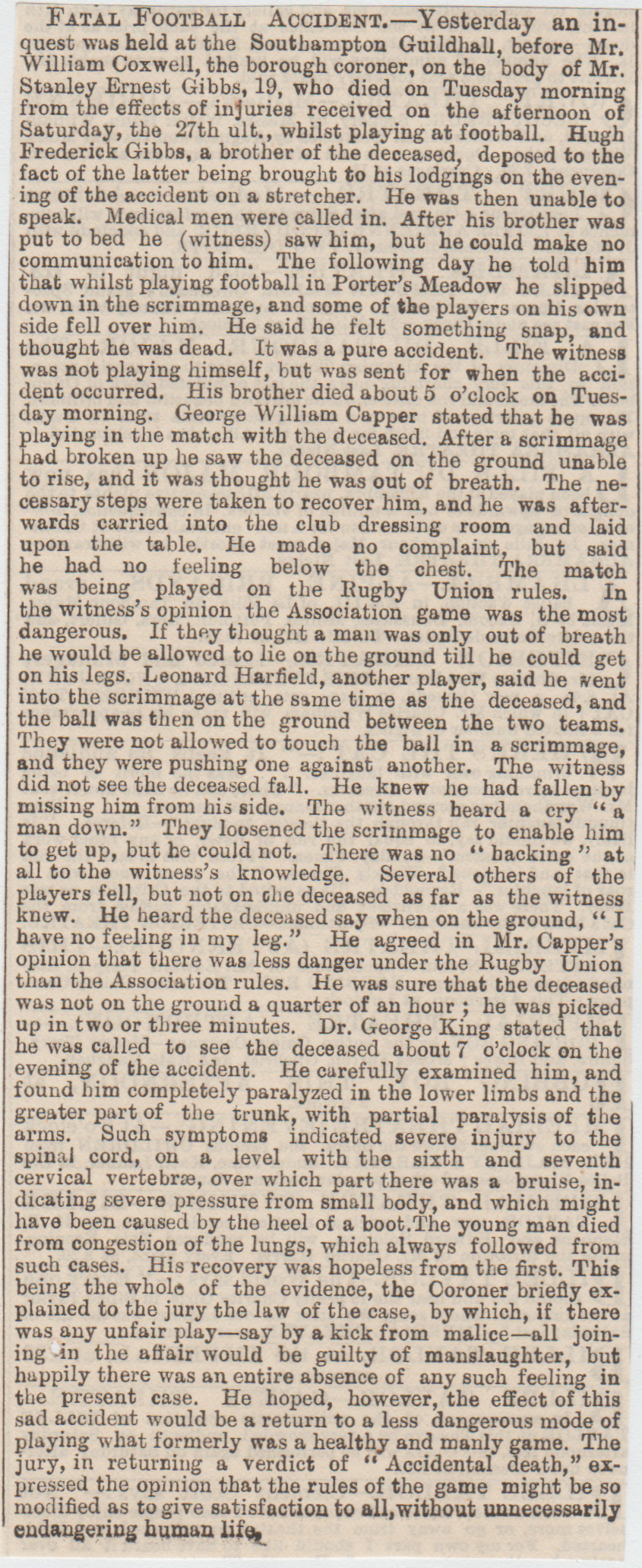
Saturday, 11th December 1880 (Mayor bans Rugby in parks)
” The Mayor, in consequence of the many serious accidents, and the recent deplorable death in Southampton, resulting from the dangerous practice of playing football, requests the heads of families, the principals of scholastic establishments in the town, and members of clubs, to take such steps as may be necessary for preventing the game being played in future according to the “Rugby Union”, the “Association”, and other rules of a dangerous character. The Mayor considers it his duty to use every means possible in his power for prohibiting the game as hitherto played being continued either in Porter’s Meadow field or upon any other part of the public lands in Southampton”

